
About UsThe Numismatic Bibliomania Society is a non-profit organization promoting numismatic literature. For more information please see our web site at coinbooks.org SubscriptionsThose wishing to become new E-Sylum subscribers (or wishing to Unsubscribe) can go to the following web page link MembershipThere is a membership application available on the web site Membership Application To join, print the application and return it with your check to the address printed on the application. Membership is only $15 to addresses in the U.S., $20 for First Class mail, and $25 elsewhere. For those without web access, write to: David M. Sundman, Secretary/TreasurerNumismatic Bibliomania
Society AsylumFor Asylum mailing address changes and other membership questions, contact David at this email address: dsundman@LittletonCoin.com SubmissionsTo submit items for publication in The E-Sylum, just Reply to this message, or write to the Editor at this address: whomren@coinlibrary.com
BUY THE BOOK BEFORE THE COINYou won't regret it! |
- WAYNE'S WORDS: THE E-SYLUM OCTOBER 5, 2008
- LATEST ISSUE OF THE ASYLUM (VOLUME 26, NUMBER 3) ON THE WAY
- FANNING NUMISMATIC LITERATURE.S FIRST MAIL-BID SALE CATALOGUE AVAILABLE
- JOHN BURNS NUMISMATIC LITERATURE VISITS NORTH CAROLINA
- BOOK REVIEW: A GUIDE BOOK OF GOLD DOLLARS BY Q. DAVID BOWERS
- NEW BOOK: ABRAHAM LINCOLN: THE IMAGE OF HIS GREATNESS BY FRED REED
- NEW BOOK: IN YANKEE DOODLE'S POCKET BY WILL NIPPER
- NEW BOOK: GRADING COINS BY PHOTOGRAPHS BY Q. DAVID BOWERS
- BOOK QUERY: DAUER BOOKS ON AMERICAN AND AUSTRALIAN CURRENCY
- BOOK IN PROGRESS: CUBAN CASINO CHIPS BY LUIS ALVAREZ
- DAVID LANGE'S NUMISMATIC AND COIN ALBUM LIBRARIES
- MORE ON THE MOST EXPENSIVE (NEW) NUMISMATIC BOOK
- ANOTHER REASON TO BUY THE BOOK BEFORE THE COIN
- SECRET SIGNATURE OF JAMES B. LONGACRE REVEALED?
- 1911 INTERNATIONAL MEDALLIC CATALOGUE NOW AVAILABLE ONLINE
- GOOGLE BOOKS POLICY ON COPYRIGHTED WORKS
- MORE ON EBAY PAYMENT POLICIES
- SOURCES FOR COLLECTING 21ST CENTURY WORLD COINAGE
- GEORGE SELGIN OFFERS HISTORICAL PERSPECTIVE ON COIN SHORTAGES
- MORE ON CIRCULATING COUNTERFEIT COINAGE IN GREAT BRITAIN
- VICTORIA AND ALBERT PLAQUES OF LEAD FROM BOIS DURCI MASTERS
- BUFFALO NICKEL FEATURED ON 1936 WORLD SERIES PROGRAM COVER
- DICK JOHNSON: REMOVE METAL WORKS FROM FAMILY GRAVESTONES
- CALL FOR DONATIONS: A MEMORIAL TO NUMISMATIST MATT ROTHERT
- ANOTHER REPORT OF THE 1858 U.S. MINT CABINET ROBBERY
- NUMISMATIC AUTHOR FINGERED IN NATIONAL COLLECTION HEIST
- A VISIT TO THE ROYAL MINT
- HOLY MACKEREL! WITHOUT SMOKES, PRISONERS TURN TO FISH AS MEDIUM OF EXCHANGE
- CORRECTION: NEW $5.00 BILL ALREADY ISSUED
- STEVE FOSSETT FIND REMINISCENT OF D.B. COOPER CASH
- FIFTY YEARS OF NASA SPACE COLLECTIBLES
- THE COIN COLLECTION AT THE MUSEO NAZIONALE ROMANO
- QUERY: WHERE IS THE GOLD COIN CLARE BOOTHE LUCE GAVE TO JFK?
- STEVEN TEMBY: AN AUSTRALIAN B. MAX MEHL?
- CELTIC COIN PROFILE RESEMBLES MARGARET THATCHER
- FIRM OFFERS GREEK-STYLED BARACK OBAMA MEDALLION
- FEATURED WEB PAGE: THE ART OF MONEYGAMI
WAYNE'S WORDS: THE E-SYLUM OCTOBER 5, 2008
 Among our recent subscribers is Wally
Schulz, courtesy of Bob Neale, Will Nipper, courtesy of Ray Williams, and
Alfredo De La Fe. Welcome aboard! We now have 1,204
subscribers.
Among our recent subscribers is Wally
Schulz, courtesy of Bob Neale, Will Nipper, courtesy of Ray Williams, and
Alfredo De La Fe. Welcome aboard! We now have 1,204
subscribers.This week we open with word on the latest issue of our print journal and updates from two numismatic literature dealers. Next we have reviews or announcements of several new numismatic books, including one on early American money.
In queries from earlier issues, we revisit topics including the most expensive coin book, counterfeit circulating pound coins, and the 1858 Mint Cabinet robbery. In the news, smoking bans lead prisoners to forms of money other than the traditional cigarettes, and a reporter visits the Royal Mint.
But I believe the most interesting item by far this week is a photograph submitted by R.V Dewey. Is it a secret signature of engraver James B. Longacre? To see for yourself, read on. Have a great week, everyone!
Wayne Homren
Numismatic Bibliomania Society
LATEST ISSUE OF THE ASYLUM (VOLUME 26, NUMBER 3) ON THE WAY
NBS members will soon be receiving their next issue of our print publication, The Asylum. Editor David Yoon writes:- Leonard Augsburger - A Bibliographic Guide to American Content in the National Numismatic Collection
- Dennis Tucker - How to Succeed in Numismatic Publishing (by Really Trying)
- Roger deWardt Lane - Self-Publishing Has Been Quite an Adventure
FANNING NUMISMATIC LITERATURE.S FIRST MAIL-BID SALE CATALOGUE AVAILABLE
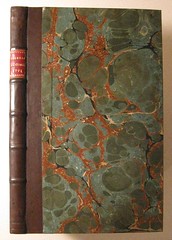 The first of the sale.s nearly 800 lots is the
Journal of the Senate, First Session of the Second Congress (1791-92),
which is significant for including the full unamended text of .An Act
Establishing a Mint, and Regulating the Coins of the United States.. This
1792 folio volume contains the entire Senate proceedings, including much
of the discussion and debate from October 1791 leading up to the passage
of the Mint Act.
The first of the sale.s nearly 800 lots is the
Journal of the Senate, First Session of the Second Congress (1791-92),
which is significant for including the full unamended text of .An Act
Establishing a Mint, and Regulating the Coins of the United States.. This
1792 folio volume contains the entire Senate proceedings, including much
of the discussion and debate from October 1791 leading up to the passage
of the Mint Act. A tall, fine copy, bound in modern half calf with shell marbled boards (well executed in contemporary style, with five raised bands and a red gilt spine label in the second resulting panel), it was felt that this foundational document was an appropriate way to begin the firm.s first sale.
The version of the Act printed in this volume retains the wording in Section X mandating the likeness of the president on U.S. coins. The bill was sent to the House for their approval, but they sent it back on March 26 with an amendment to this section, which the Senate initially refused. After the House adhered to its amendment, the Senate receded from its disagreement.
The bill was enrolled on March 28 and signed on March 30 by Vice-President John Adams, following the signing of the bill by the Speaker of the House of Representatives. On April 2, 1792, President Washington approved and signed the Act.
There are only three recorded 1792 printings of the .Act Establishing a Mint,. the other two being only the text of the Act itself, without the Congressional context leading up to and surrounding it. Only the present printing gives this important contextual information, allowing the reader to appreciate the Act.s full significance. This copy is in excellent condition, with an attractive binding that, while modern, is in contemporary style. Of unparalleled importance and quite rare.
To read the entire lot description, download the October 28 sale at www.fanningbooks.com.
JOHN BURNS NUMISMATIC LITERATURE VISITS NORTH CAROLINA
Numismatic literature dealer John Burns and his stock of ancient, medieval and foreign numismatic literature was at the North Carolina State show in Hickory, NC this weekend. One big seller was Pierre Fricke's new book on Confederate paper money.On a non-numismatic note, John adds:
BOOK REVIEW: A GUIDE BOOK OF GOLD DOLLARS BY Q. DAVID BOWERS
A Guide Book of Gold Dollars 2008 by: Q. David Bowers
Reviewed by John and Nancy Wilson, NLG
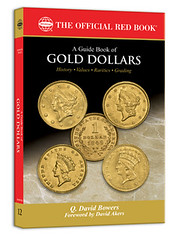 Once again Whitman and Q. David Bowers have hit a
home run with this informative and excellent Red Book reference on Gold
Dollars. The 288 page reference has within its pages the, .History,
Values, Rarities and Grading of gold coins along with full-color
illustrations. David Akers wrote an excellent Foreword for the reference.
Once again Whitman and Q. David Bowers have hit a
home run with this informative and excellent Red Book reference on Gold
Dollars. The 288 page reference has within its pages the, .History,
Values, Rarities and Grading of gold coins along with full-color
illustrations. David Akers wrote an excellent Foreword for the reference.
It is amazing how many great numismatic books Mr. Bowers authors every year. We once asked Dennis Tucker and Mary Counts from Whitman if we could subscribe to Q. David Bowers book of the month club and they laughed. This most recent guide to Gold Dollars will help beginning to advanced collectors, dealers and investors with their pursuit of coins in this interesting series.
The book covers US gold dollars from inception to the last piece minted. Each piece by date and mint is detailed separately giving value by condition along with details and interesting bits of information about that piece. Estimated populations along with die date and auction information is well covered. Types I, II and III Gold Dollars have also had an excellent study done on each coin. The appendix contains record auction prices which would be useful to the collector and dealer. You will also find information on mints and the minting process.
We especially liked Chapter 5 which dealt with, .How to be a smart buyer.. This chapter by itself contains information that will help you greatly with your collecting of gold coins. The Selected Bibliography has sources that will help the researcher as well as collector find out more information on gold coins.
If you collect U. S. gold coins you will also want to consider purchasing Mr. Bowers reference on United States Gold Coins: An Illustrated History; along with the Encyclopedia of U. S. Gold Coins, 1795-1933, by Authors Jeff Garrett and Ron Guth.
The Official Red Book .A Guide Book of Gold Dollars,. is a Softcover reference priced at $19.95. It can be purchased directly from Whitman Publishing, LLC, 3101 Clairmont Road, Suite C, Atlanta, GA 30329, phone number 1 (800) 546-2995 or visit their web page www.whitmanbooks.com
NEW BOOK: ABRAHAM LINCOLN: THE IMAGE OF HIS GREATNESS BY FRED REED
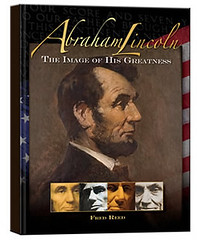 For numismatists, Lincoln is a unique figure, having
appeared in total on more coins (billions of one-cent pieces) and paper
money (billions of $5 bills) than any other person in history. In addition
he appears on various world coins, countless tokens and medals, and, for
philatelists, U.S. and foreign postage stamps. In 2009 the U.S. Mint will
release four new reverse designs for the Lincoln cent, representing
different phases in his life, as well as a commemorative silver dollar. In
2010 it will be Lincoln.s turn on a Presidential golden dollar.
Undoubtedly it will be the most popular of the series, saved by millions
of collectors worldwide.
For numismatists, Lincoln is a unique figure, having
appeared in total on more coins (billions of one-cent pieces) and paper
money (billions of $5 bills) than any other person in history. In addition
he appears on various world coins, countless tokens and medals, and, for
philatelists, U.S. and foreign postage stamps. In 2009 the U.S. Mint will
release four new reverse designs for the Lincoln cent, representing
different phases in his life, as well as a commemorative silver dollar. In
2010 it will be Lincoln.s turn on a Presidential golden dollar.
Undoubtedly it will be the most popular of the series, saved by millions
of collectors worldwide.Later this year a new book will debut, by award-winning author and numismatic researcher Fred Reed. Abraham Lincoln: The Image of His Greatness is a remarkable creation. Harold Holzer, of the Metropolitan Museum of Art (and cochairman of the United States Lincoln Bicentennial Commission), calls it .interesting and compelling,. saying that .Reed.s commentary and the arrangement and choice of imagery make Abraham Lincoln: The Image of His Greatness a very worthwhile and elegant project..
Dr. Thomas Turner, longtime editor-in-chief of the Lincoln Herald (the oldest continuously published journal devoted to the life and career of Abraham Lincoln), calls it .a unique study. that .makes a significant contribution to the field..
Reed draws on his own unparalleled collection of Lincoln numismatic items, illustrating the book with hundreds of full-color images sure to delight the collector and historian. These are joined by engravings and daguerreotypes, old film stills, a never-before-published oil painting, magazine covers, political cartoons, and a host of other images. They are poignant, provocative, profound, sometimes puzzling; individually fascinating and collectively illuminating.
NEW BOOK: IN YANKEE DOODLE'S POCKET BY WILL NIPPER
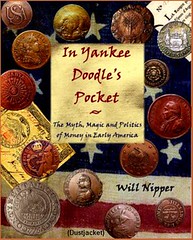 I asked Ray Williams (President of the Colonial
Coin Collector's Club) about the book. He writes:
I asked Ray Williams (President of the Colonial
Coin Collector's Club) about the book. He writes:
He has accumulated a lot of colonial and early federal history, along with the coins in commerce circulating during those periods. This has as much history as it has information about the coins. This is not a C4 publication and has not been edited by our editors. It is a summary of Will's research and personal observations. He published this privately.
It is about 560 pages including the index and endnotes, hardcover with a very attractive glossy dust jacket. The dust jacket has beautifully taken and printed images, as opposed to the low res image on the website. The paper for the pages is a nice quality, but I don't know what it's called.
This book would be appreciated by a novice entering the field of colonial coinage, as well as the advanced collector looking for information about the series he specializes in. I do plan to purchase a second unautographed copy that I can make notes in. When I do obtain a nice autographed copy of a book, I like to keep it clean of my chicken scratch.
On that website, the final paragraph of the preface seems to accurately sum up the book.
From the Preface:
If I have succeeded then neither hardcore historians nor serious numismatists are likely to be fully satisfied.
Ray kindly put me in touch with the author. Will Nipper writes:
I've set up a 25% discount code on the website. Your readers can take advantage of the discount by entering "esylumreader" in the shopping cart's special offer code.
- Size: 8.5 x 11 inches, 576 pages, 4 lbs. 6 ounces
- Binding: Premium hardcover, sewn, copper foil stamping on front and spine
- Printing: Halftone black on 60 lb. white matte paper (chlorine-free, partially from post-consumer waste)
- Dustjacket: Full color front and back, glossy
- $58.95 + Shipping & Handling
- Custom inscription by author available on request.
For more information on the publisher's web site, see: In Yankee Doodle.s Pocket (http://www.bowmanstonepress.com/index_files/detailspage.htm)
NEW BOOK: GRADING COINS BY PHOTOGRAPHS BY Q. DAVID BOWERS
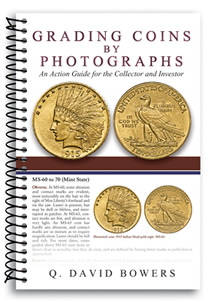 No subject is more important to the rare-coin
collector or investor than grading. Learning to grade the right way can
save you hundreds or thousands of dollars. Now, award-winning professional
numismatist Q. David Bowers has written a unique set of step-by-step
grading instructions for every U.S. coin, from half cents to double
eagles. He explains the evolution of grading standards, how to .read. a
coin.s surfaces, expert techniques, smart buying tips, aspects of today.s
marketplace, and more. This detailed, insightful text is combined with
hundreds of high-resolution color photographs to help you grade your
entire coin collection.
No subject is more important to the rare-coin
collector or investor than grading. Learning to grade the right way can
save you hundreds or thousands of dollars. Now, award-winning professional
numismatist Q. David Bowers has written a unique set of step-by-step
grading instructions for every U.S. coin, from half cents to double
eagles. He explains the evolution of grading standards, how to .read. a
coin.s surfaces, expert techniques, smart buying tips, aspects of today.s
marketplace, and more. This detailed, insightful text is combined with
hundreds of high-resolution color photographs to help you grade your
entire coin collection.Grading Coins by Photographs will be available before Thanksgiving 2008. It has 384 pages, is spiralbound for ease of use, and is illustrated in full color. It covers circulated, Mint State, and Proof coins. The retail price is $19.95.
.David W. Lange, research director, NGC
.Jeff Garrett, numismatic author and coin dealer
To read the complete article, see: Grading Coins by Photographs (http://www.whitmanbooks.com/Default.aspx?
Page=55&HTMLName=ReviewUpcoming_1008)
BOOK QUERY: DAUER BOOKS ON AMERICAN AND AUSTRALIAN CURRENCY
Howard A. Daniel III writes:From the web site:
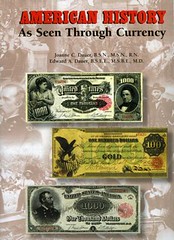 "American History As Seen Through Currency" by
Joanne C. Dauer and Edward A. Dauer is a companion volume to "Australian
History 1901 to 2001, As Seen Through Banknotes". Over 390 pages in full
colour, this impressive work is now on sale at a special price!
"American History As Seen Through Currency" by
Joanne C. Dauer and Edward A. Dauer is a companion volume to "Australian
History 1901 to 2001, As Seen Through Banknotes". Over 390 pages in full
colour, this impressive work is now on sale at a special price!
For the first time, see from the library of one of America's foremost collectors of U.S. paper currency, some of the rarest bills ever engraved. Learn about the historical events that occurred when these notes were printed, spanning the years 1861 to 1929.
The currency notes are reproduced in full colour from high-resolution digital files. Read the fascinating history behind many of these one-of-a-kind notes, some with a market value in excess of $1,000,000. All three notes pictured on the cover are unique outside government holdings.
About the Australian currency book:
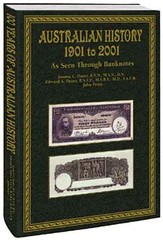 The history of the evolution of Australian
currency notes since Federation is a fascinating one. With the foreword
written by by Ian Macfarlane, Governor of the Reserve Bank of Australia
from 1996-2006, this volume brings an international perspective and
significant new information to the History of Australian Currency. The
official note issue begins with the superscribed series printed by the
Government before World War I, and ends with today's polymer
notes.
The history of the evolution of Australian
currency notes since Federation is a fascinating one. With the foreword
written by by Ian Macfarlane, Governor of the Reserve Bank of Australia
from 1996-2006, this volume brings an international perspective and
significant new information to the History of Australian Currency. The
official note issue begins with the superscribed series printed by the
Government before World War I, and ends with today's polymer
notes.This limited edition leather-bound book with slipcase has previously unpublished banknote images and information sourced from the Reserve Bank of Australia Archives, leading collectors, dealers, historians, mesuems, and the Dauer Collection.
With the collaboration of the Reserve Bank, this 352 page full-colour tome extensively covers Pre-Federation 1851 to 1900, Federation notes from 1901 to 2001, military issues of both World Wars and Vietnam, and 20th century shinplasters.
BOOK IN PROGRESS: CUBAN CASINO CHIPS BY LUIS ALVAREZ

DAVID LANGE'S NUMISMATIC AND COIN ALBUM LIBRARIES
David W. Lange, Research Director at Numismatic Guaranty Corporation (NGC) writes:
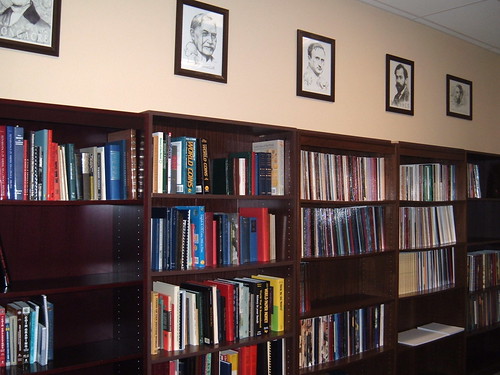
Thanks for sharing these with us! Who else would like to send us a shot of their numismatic library? -Editor
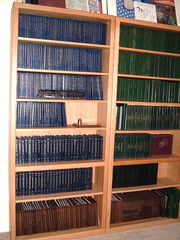
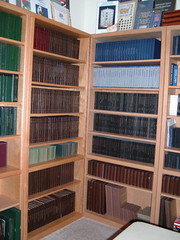
THE BOOK BAZARRE
MORE ON THE MOST EXPENSIVE (NEW) NUMISMATIC BOOK
Regarding Len Augsburger's question about the most expensive numismatic book (at issue price), Tom Wetter writes:Auction results have sold it as accompaniments with ingots for over $80,000 (Heritage 7/04, Lot 8787) and on the secondary market for just over $3,850 (Stack's 5/08, Lot 4011). However, it was never offered publicly for sale, which may disqualify it from this contest!
ANOTHER REASON TO BUY THE BOOK BEFORE THE COIN
It had been offered to several other dealers who felt it was a fake because of the reeded edge. Go figure - all they had to do was look at the RED BOOK. So with a $12.00 book in hand the fellow purchased a wonderfully rare and historic piece. He is a young man with a young family and will probably use the proceeds for a good home and nest egg. I suspect he will become a book buyer as well.
When asked about the coin the dealer had no regrets and was happy that the fellow purchased it. One of my good buds was at the show and is not given to rumors. He had first hand knowledge of the events. So keep your eyes pealed for what will be some very spirited bidding when the coin does show up for auction.
SECRET SIGNATURE OF JAMES B. LONGACRE REVEALED?
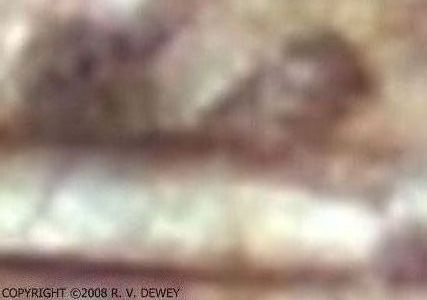
R. V. Dewey writes:
The best way to view this image is in a totally darkened room. Put the image on your screen and walk away a comfortable distance to view it. Try and acclimate your eyes for a few minutes to the lighting conditions from 3 to 10 feet from the screen. Let your eyes wander and have an open, receptive mind and enjoy for the first time ever, secret artwork from the engraver never intended to be seen by us, the .outsiders..
These early 19th Century vignettes by Mr. James Barton Longacre do not scream for attention, as they merely whisper to those who will listen intently.
If you can see J.B.L..s face, (to the right of the top center triangle), his bold signature is below and to the right of his self portrait.
Mr. Longacre.s signature resembles a boat anchor with the J and the L sharing a common vertical line. The top left horizontal bar of the signature appears to touch his chin. Notice that the J in the .anchor. gently turns upward, while the L terminates (in the far right .white strip. area) in a diamond shape or arrow design. Could that be Jim.s dog at the far top left?
Play, connect the dots, with the black spots at the far top left and watch the faces shift from one face to another, go very slowly. Notice the three spots that vaguely resemble the constellation Orion angling upwards. Focus on the two spots to the right then the two to the left. Take your time - he is a wonderful artist!
Tip #1: viewing your screen standing up from the far left side, find the dots that make the upside-down isosceles triangle (top left area). This will bring the .big dog. into focus every time.
Tip #2: do not get discouraged, patience will prevail. Remember these micro engravings were for his personal enjoyment, not ours! To view these images we become guests in Mr. Longacre.s miniature world of camouflage, image-shifting and plausible deniability!
1911 INTERNATIONAL MEDALLIC CATALOGUE NOW AVAILABLE ONLINE
No announcement was made after the book was digitized June 3, 2008. I happened to come across its availability while searching for galvano plaques. Although the book has been in my library, it seems like forever, it is good to know it can be accessed online. It is long out-of-print and, of course, its copyright has expired.
The 1910 exhibition of medallic items was held, along with coins, in the new building of the ANS, that the organization had just occupied on Audubon Terrace in New York City with three other museums at the time, all built with the benevolence of Archer Milton Huntington. The exhibition was so large, it actually spilled over (maybe that's a poor choice of words -- better say, some of the coins were exhibited) in its neighbor museum, the Hispanic Society (now in the news a century later for wanting $30 million of its coins back from ANS because they moved away).
Under committee chairman Edgar H. Adams, invitations were sent out in the Autumn of 1909 to medallic artists and mints all over the world. The response was so great that the resulting exhibition was the World's Greatest Medallic Exhibition Ever Held! It has not been surpassed since, not even by an international organization, FIDEM (Federation Internationale de la Medallie), holding biennial international medallic exhibits since 1949.
In theory, FIDEM biennial exhibits are the latest works international medallists, engravers and diesinkers have created in the two most recent years. What the ANS 1910 exhibition contained was the best work every world medallists had created at anytime in their career! Artists were not limited in the number of medallic items they could submit. French medallist Louis Oscar Roty sent 83! Victor D. Brenner submitted 69 medallic works for exhibit.
The ANS exhibit cases were packed and overflowing. It filled the exhibition gallery on the first floor, center cases, and a mezzanine above in the new building. Mounting all the medallic items must have been a chore!
One hundred ninety-four artists from 11 different countries, three mints and three medallic societies sent medallic items for exhibit. French artists (49) sent the most, following native artists understandably here in America (56), emphasizing the fact medallic art is somewhat a French art. German (23), Austrian (19), British (16), Belgium (11), Italian (9), Dutch (7), Spanish (2) Norwegian (1) and Swiss (1) artists also participated.
In all 2,043 items were on exhibit. No limit on composition, how made, style or themes. Eight were hand engraved, 45% were struck, 30% cast and 319 (15.6%) were in galvano form. There was a handful of terracotta, porcelain, marble, wood, stone and ivory items. Seven items were in wax (the only requirement here was wax items had to be under glass).
A small (octavo) format catalog of the coins on exhibit was published in time for the 1910 exhibition, on view March 9 to April 1, 1910. The 252-page catalog listed 3,506 numismatic items. There were only 8 plates. A similar catalog listed medals; it is not, however, to be confused with the 1911 catalogue of medals, now considered a second revised edition. Records at ANS indicate 5,547 visitors viewed the exhibits.
Thanks to Agnes Baldwin Brett, a volunteer who oversaw the preparation of the larger quarto format medal catalog, every item was photographed, some singularly, others grouped as mounted by artist for the exhibit. She wrote one of the most authoritative Introductions, with a masterful understanding of the field, the history of medals and the many ways in which medallic items can be produced. She even chose to illustrate a Janvier die-engraving pantograph (at Medallic Art Company), which had been in America for only three years at the time, but it was considered the ultimate tool for coin and medal production at the beginning of the new century.
It is a miracle this massive 412-page book was published even within a year after the exhibition with all the photographs. Titled Catalogue of the International Exhibition of Contemporary Medals, all were issued with a tan paper cover in a white cardboard box. Printed tissue interlays for many plates identified medallic items by catalogue number. A reply post card was inserted to mail back to ANS to indicate the purchaser of the book. If you found a bound copy for your library it was bound by a previous owner. One thousand copies were printed.
In conversation and among its scholarly references the book is cited by its title initials, "IECM." In almost a century no other publication has come anywhere near matching it. We wonder if a similar medal exhibit could even be mounted today. In August 2002 I sent a letter to the officers of ANS to consider a similar exhibition in 2010, eight years in the future. They never even answered my letter. We may never have another World's Greatest Medallic Exhibition Ever Held!
You may access the catalogue at the following URL: To read the complete article, see: Catalogue of the International Exhibition of Contemporary Medals (http://books.google.com/books?id=dEJmAAAAMAAJ&
printsec=frontcover&dq=Catalogue+of+the+International+
Exhibition+of+Contemporary+Medals)
GOOGLE BOOKS POLICY ON COPYRIGHTED WORKS
I wondered why anyone would care to buy the book, if it can be read on the internet, so I wrote the publisher. His answer follows:
Google take a copy of each published book and allow 20% of the book to be searchable on the web. (If you start at the front cover of the book on-line and scroll down, you'll see a yellow note between the cover and subsequent page that explains this is a preview only. The user can preview up to 20% of the pages, but then they hit the 20% limit and will not be able to view any additional pages. Google monitor the number of hits.)
he Amazon .Look-Inside-the-Book. is not searchable. The general consensus is that the Google ability to search for specific text or topics within a title offers the end user a very high level of certainty that .this is the book they need to purchase., hence the choice of Google. Indeed, Cambridge University Press uses the Google Book Search facility. You will notice that the opening Google page preview states: The total pages displayed will be limited.
MORE ON EBAY PAYMENT POLICIES
Greg Heim (eBay seller "gynandroidhead") writes:1) The "PayPal thing." 11 out of every 12 orders that I get are from PayPal, so that's not a big deal for me. However, you can still do business with your customers who do not pay electronically, you just cannot use eBay's "Checkout" to do so.
2) The "4.3" thing: This is more disturbing. As of November 1, if ANY of your four components (S&H, Shipping Time, Communication, Item as described) are under a 4.3 for a current 30 day period, eBay will pull the plug on your future listings until your rating goes up. I can see where under a 4.0 is reasonable, but a 4.3 is asinine. Talking to other Powersellers, the problem is that most buyers do not realize that rating you a "4" is putting you out of business as eBay's wording of these rating needs to be revised.
3) The "Free Shipping" thing: Let's say you sell a $100 item and charge $4.95 S&H with D.C. and Insurance. Ebay only gets fees on the $100. If you offer free shipping, that customer may pay $102 for it, hence eBay is making more money. However, I run no reserve auctions starting at under $1.00. Free shipping is not an option for me. As a corollary to the above point, a lot of sellers (including me) have been getting hammered here because buyers do not take into account the cost of materials and "reasonable" processing time for a lot.
SOURCES FOR COLLECTING 21ST CENTURY WORLD COINAGE
Regarding your review of the 2001-Present Standard Catalog of World Coins, you wondered if any dealers supply modern circulating coinage:
Am I wrong? Is there a dealer or specialty organization that seeks out and distributes these coins to collectors?
Well, there are a few dealers around who offer wide selections of many modern type coins. In the U.S. we have Lauren Benson, Inc., that offers individual minors and small to mid-sized sets of circulating coins. The company is run by Lauren's son, Richard Benson and they produce a monthly printed price list. Email them at bensoncoins@netins.net
Many modern circulating coins of the world host animal designs. A good source of these types can be found at The Coin Lode, run by Al Beck. Check out his website at http://www.coinlode.com/
Many European dealers offer modern issues and a few offer a broad selection well beyond the typical Euro coinage. A. Jorg Numismatik is one that produces a price list and hosts a website at www.ajoerg.de Another would be Munzen-Schoenawa who produces price lists and can be reached by email at Hartmut.Schoenawa@t-online.de
Most coin dealers also offer circulating coins from their areas of specialty, so if you are looking for modern Islamic coins you might contact Steve Album or Joe Lang through their website at www.stevealbum.com
Some major wholesale dealers who trade in modern issues include Coin Invest Trust at www.coin-invest.li and Mietens & Partner GmbH at www.mietens.de Plus there are several smaller wholesalers that travel to larger shows like the ANA Convention, FUN show, CICF, NYINC, Baltimore and Long Beach shows. Some of these fellows are willing to sell direct to collectors or to connect you with a retailer they supply.
And of course, there are some very good trading networks for modern issues which have developed in the internet era. If you would like to connect with circulating coin collectors in other countries with an eye towards trading, try World Coin Traders at http://www.terra.es/personal4/jo7lan/listadocol/index.html

GEORGE SELGIN OFFERS HISTORICAL PERSPECTIVE ON COIN SHORTAGES
 Coin dealers and collectors are still reeling
from the U.S. Mint's announcement that it had run out of American Eagle
gold coins. But what ought to surprise every American isn't that a
government agency came up short. It's that the U.S. government should be
making little metal discs at all.
Coin dealers and collectors are still reeling
from the U.S. Mint's announcement that it had run out of American Eagle
gold coins. But what ought to surprise every American isn't that a
government agency came up short. It's that the U.S. government should be
making little metal discs at all.Coin shortages are nothing new. A few months before running out of gold Eagles, the U.S. Mint had to ration silver Eagles. Not long before that, pennies were in very short supply. Nor are other government mints any better. Back in 2007, for instance, Argentina had such a severe change shortage that its panhandlers nearly starved to death, while in southern China 100-yuan coins commanded a whopping 25 percent premium.
Why are coin shortages so common? Governments typically blame unexpected changes in demand. But suppliers of all sorts of other goods manage to avoid running out despite even more dramatic demand changes. So what's special about coins? An old chestnut says that, if the government were put in charge of the desert, pretty soon there'd be a sand shortage. Recall the plight of consumers under socialism: socialist governments tried to make everything and eventually ran out of everything.
Now socialism is dead, but not when it comes to coining. So coin shortages keep breaking out, as they have ever since governments first monopolized coin making in ancient times.
Private coiners played a still bigger role in Great Britain's Industrial Revolution, which was in danger of grinding to a halt thanks to a shortage of official coins. When the Royal Mint refused to do anything about the shortage, private entrepreneurs took matters into their own hands. From 1787 to 1797 and again from 1811 to 1818, the greater part of Great Britain's stock of coins came, not from the Royal Mint in London, but from a score of private mints in Birmingham.
Far from having been inferior to their Royal Mint counterparts, as government officials would have it, Great Britain's private coins were more popular than official ones, and for good reason: being much harder to counterfeit, they were more likely to be genuine. But the British government cared more about protecting the Mint's monopoly than with catering to the public's need for sound money, so in 1818 it banned private coins, even though official ones were still in short supply.
To read the complete article, see: Get Government Out of Coin Manufacture (http://www.numismaster.com/ta/numis/Article.jsp?
ad=article&ArticleId=5364)
MORE ON CIRCULATING COUNTERFEIT COINAGE IN GREAT BRITAIN
Speaking of privately-manufactured coinage, last week's item on counterfeit British one pound coins prompted Dick Doty to write:VICTORIA AND ALBERT PLAQUES OF LEAD FROM BOIS DURCI MASTERS
Regarding our discussion of numismatic items made from bois durci ("hardened wood") molds, Harry Mernick writes: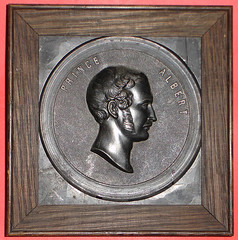
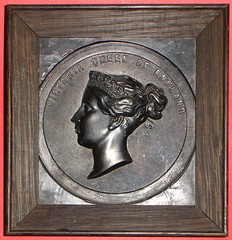
BUFFALO NICKEL FEATURED ON 1936 WORLD SERIES PROGRAM COVER
 My favorite baseball / numismatic ephemera
combination comes in published form. The 1936 World Series featured cross
town rivals, the New York Giants against the New York Yankees. The Giants
fielded the likes of future Hall of Famers Mel Ott and Bill Terry and the
Yankees were shouldered by the great Lou Gehrig and an upstart rookie
named Joe DiMaggio.
My favorite baseball / numismatic ephemera
combination comes in published form. The 1936 World Series featured cross
town rivals, the New York Giants against the New York Yankees. The Giants
fielded the likes of future Hall of Famers Mel Ott and Bill Terry and the
Yankees were shouldered by the great Lou Gehrig and an upstart rookie
named Joe DiMaggio. But the real star of the series (at least in my eyes) was the 1936 World Series Official Program, which featured cover art prominently displaying the reverse of the buffalo nickel. Grant Powers was the artist who created the cover. A veteran of both WWI and WWII, he is most noted for his WWII watercolor paintings of Bikini Atoll naval battles in the Pacific. Several of his works are displayed in the Naval Historical Center in Washington D.C. Exactly how he came upon the commission to paint the World Series program cover is undetermined.
The artwork is layered, so to speak; in the foreground are the home plate umpire, the catcher, and the batter who appears to have just stroked a base hit. Immediately in front of the batter, is the larger than life buffalo nickel rising up from the pitchers position in the middle of the diamond. Behind the nickel is the darkened silhouette of the New York skyline in front of an orange night sky.
The wording in the lower left reads; .World Series .Giants vs Yankees- 1936., and to the right .Official Program 25c.. The legends .United States of America. and .E Pluribus Unum. appear on the nickel along with the bison. I obtained a replica of the program for about $40 on an internet auction site, however, original copies turn up occasionally and usually command $250 -300. A framed copy of the cover makes a great wall piece for the baseball fan / numismatist.
Inside the program is filled with the usual player profiles along with plenty of advertising. It was published by Harry M. Stevens, Inc. of New York. Unfortunately there is not any information about the artist or what may have inspired his choice of the buffalo nickel. It can be surmised he was an admirer of James Earle Fraser.s .all American. coin design and used it as a symbol of .America.s pastime., and he must have been a purist for Fraser.s original design; whereas, Mr. Powers found himself in a unique position to put the buffalo back on the mound.
DICK JOHNSON: REMOVE METAL WORKS FROM FAMILY GRAVESTONES
Dick Johnson writes: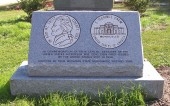 Neither the item in last week's E-Sylum on the
Felix Schlag cemetery monument, nor the original article describes the
monument in detail. Is the Jefferson nickel design engraved in the head
stone? Or is the design in some material affixed to the stone?
Neither the item in last week's E-Sylum on the
Felix Schlag cemetery monument, nor the original article describes the
monument in detail. Is the Jefferson nickel design engraved in the head
stone? Or is the design in some material affixed to the stone?
The trouble is, the galvano has been on the stone for 80 years. It may shatter if removed. My recommendation was to have a modern sculptor make a plaster cast -- on site! -- before it is removed, particularly if this is the only such relief of the portraits extant. Then have a monument maker remove the metal galvano.
Metal and stone are the only permanent material to replace it. An inexpensive epoxy cast could be used for the replacement. However epoxy is not permanent, but it would dissuade thieves as it does not look like metal.
CALL FOR DONATIONS: A MEMORIAL TO NUMISMATIST MATT ROTHERT
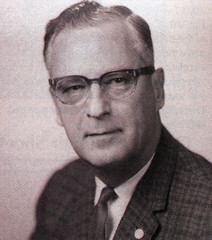 The article last year on 50th anniversary of former
ANA President Matt Rothert's successful campaign to have the religious
sentiment "In God We Trust" emblazoned on our paper money was much
appreciated by friends and family members of the deceased legendary
numismatist.
The article last year on 50th anniversary of former
ANA President Matt Rothert's successful campaign to have the religious
sentiment "In God We Trust" emblazoned on our paper money was much
appreciated by friends and family members of the deceased legendary
numismatist.Matthew Rothert Jr., Matt's son who now lives in Michigan, and who with other family members had received copies of the article from his sister, Mrs. Taft. Matt Jr. also wrote me a nice note. "Thanks for your interest in my Dad and even going to Camden - no easy drive I-40 from Memphis to Little Rock.
"You might already know this, but if not, on Dad's tombstone in the Camden Cemetery, it has his name and 'In God We Trust." Also in Hot Springs, Ariz., there is a sidewalk block that gives him credit. "However, I do believe it very important to give Dad some credit in Camden, and thank you for your efforts," he added.
All of this leads up to my suggestion in the previous column that someone, some group of individuals, some numismatic organization, or even one of our many fine dealers, partner with the City of Camden - who would be very responsive, I was told - to erecting a suitable memorial to Mr. Rothert in the center of the City of Camden, Rothert's hometown.
The cost is small. The local preservationist told me $1,000 to $2,000. And the payback would be great.
So once again I put the fleece out there. It's few of us collectors who can ever have the impact on the world at large that numismatist Matt Rothert had. It's now been more than a half century since he reshaped our nation's paper money. Isn't it high time that our hobby memorialize his achievement for posterity?
If you are interested, I can put you in contact with the appropriate parties.
To read the complete article, see: Feds Look to Second Anti-Photographic Ink (http://www.numismaster.com/ta/numis/Article.jsp?ad=article&ArticleId=5361)
THE BOOK BAZARRE
numismaticbooks@aol.com PH: (719) 302-5686, FAX: (719) 302-4933. Visit our web site www.finenumismaticbooks.com
ANOTHER REPORT OF THE 1858 U.S. MINT CABINET ROBBERY
Inspired by John Dannruether's inquiry about the 1858 robbery of the U.S. Mint coin cabinet, Rich Kelly & Nancy Oliver write:The United States Mint, in this city, was yesterday morning visited by three gentlemanly looking strangers, who, while making a tour of the institution, succeeded in robbing the cabinet of rare coins, which are preserved as an object of a special interest and value.
The strangers succeeded in abstracting two $50 Gold pieces, one slug worth $40, four $20 gold pieces, one $20 California gold coin, and one $25 gold piece. The scamps affected the robbery by means of a false key, with which they unlocked the cabinet during the momentary absence of the attendant.
The robbery was discovered soon after the strangers had left. Information of the fact and a description of the thieves was left at the Recorder.s Office. Officers were at once set upon the watch, and, a short time afterwards, one of the thieves was found at the store of Messrs. Charpless and Brothers, endeavoring to pass off one of the stolen coins. The coin, being somewhat unique, was taken by the clerk to a broker.s office, in order that its genuineness might be place beyond a doubt. The broker, fortunately, had heard of the robbery, and pronounced the coin in question to be a part of the avails of that affair.
A few minutes afterward another of the party of thieves entered a store near Eighth and Chestnut Streets, and desired change for another of the stolen coins. The unusual character of the coin, being also a subject of remark, suspicion was excited, and both the adroit scamps were soon placed under lock and key. They gave their names as Charles Morris, and Charles Mervine.
The robbery was a bold one, and must have been preconceived for some time. It is probable that on a former visit an impression of the lock was taken in wax, and that a key to fit it was prepared at leisure. That it fitted the lock with accuracy is manifested from the very brief space of time required to accomplish the opening of the cabinet and the abstraction of the golden contents. They were identified as having formerly visited the institution.
NUMISMATIC AUTHOR FINGERED IN NATIONAL COLLECTION HEIST
In Dickeson's 1859 book The American Numismatical Manual he explains the reason he had to do this. "The fac-similies of this work - numerous and expensive - are of themselves such a collection for the general observer, and the young collector of coins, as has never before been produced".
He had to pay for these colorized lithographic plates in some manner! Apparently, the loot was kept by the Rosenthal lithogrpahers as payment and may eventually surface at anytime; probably through a family heir.
Not being snooty about the transaction, in the preface Dickeson presented his thanks to "Jacob R. Eckfeldt and William E. DuBois Assayers of the U. S. Mint; Hon. James Ross Snowden, Director of the Mint; other officers of that institution and to numerous private individuals". The two undergrads were not specifically mentioned by name.
The two items regarding Dannruether's inquiry were the Templeton Reid $25 gold coin, and the F.D. Kohler $40.07 gold bar. These were illustrated in Dickeson's 1859 encyclopedia on plates #18 and #19. After the lithographs were finished, Dickeson hurried over to J.B. Lippincott's print shop and got the books ready to be sold in the new and exciting 1859 coin collecting market. This was just in time for Ed Cogan's sale of J N T Levick's collection that December. They also made wonderful Christmas gifts that year.
Dickeson quickly sold out of this first run and ordered a second printing with an 1860 copyright date. In order to save ink, he shortened the name a bit to "Numismatic Manual" in the second edition. This word "numismatic" (describing the "crazies" who were buying proof sets and other weird items) took hold and today we even have an American coin collector's association by that name.
The $40.07 Kohler bar hasn't been seen since, but we do have a substitute one with a higher valuation of $47.71. John Ford acquired this in 1956 and quickly sold it to Mrs. Norweb. As for the Templeton Reid $25 coin, we now have a copper one that was owned by John Ford in the late 1950's. This too, was a "Franklin Hoard" item. Ford wanted to get it tested at the time, but had reservations about the outcome. Perhaps it is the long lost gold piece that was cleverly copper plated by Ford to conceal its real identity.
There's so much to uncover in the wide, wide, world of American numismatics!
A VISIT TO THE ROYAL MINT
And with hard cash back in fashion as savings go back under the mattress, business is booming at arguably the world's oldest financial institution. This is a place where none of the 738 staff is allowed to bring a single piece of money into work and normal vocabulary does not apply. They don't say 'heads' or 'tails' round here. They talk about 'obverses' and 'reverses'.
Entering the storage area, I imagine that this is what life must have looked like at the court of King Midas. There are bags of money, sacks of money, wooden boxes of money and great cardboard crates of money. There is a warehouse full of money piled as high as a five-storey house.
With the economic downturn, however, comes an upturn in crime. Last week, it was announced that forgeries now account for an alarming 2 per cent of the 1.5 billion #1 coins in circulation.
Down here in South Wales, this lot can spot a dud at a glance and are working on ways to flush the bad stuff out of the system.
Every coin, though, starts its life in the Engraving Department, where I expect to meet a collection of half-blind old men in white coats designing unicorns.
Instead, I find a small team of art graduates led by the Chief Engraver, Matt Bonaccorsi, who is only 35 and wears jeans and an earring. His team work on around 500 designs a year. Today, one of them is busy engraving Edward II for a new silver coin for the collectors' market.
Another is preparing an engraving of Lord Trenchard, father of the Royal Air Force, which will be stamped on a special #5 RAF commemorative coin for St Helena (even though it has no airport or planes).
Before I leave, I ask for a crash course in spotting fake pound coins. Paul Morgan, product development manager, produces a good one and a bad one and asks me to tell the difference.
I haven't a clue until Paul advises me to study the colour. The fake is darker and almost stained. Then he points out that the design and the year do not match (different years should have specific designs; for example, the Forth Bridge is only on the 2004 coin).
Different years also have different inscriptions on the side. The 'm' on 'Decus et Tutamen' ('an ornament and a safeguard' - Virgil) looks as if it has been scratched on by a child. In fact, there are many clues for the knowing eye.
To read the complete article, see: Absolutely minted! Robert Hardman escapes the credit crunch to explore the Royal Mint (http://www.dailymail.co.uk/news/article-1068045/
Absolutely-minted-Robert-Hardman-escapes-credit-crunch-explore-Royal-Mint.html)
HOLY MACKEREL! WITHOUT SMOKES, PRISONERS TURN TO FISH AS MEDIUM OF EXCHANGE
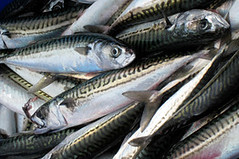 When Larry Levine helped prepare divorce papers
for a client a few years ago, he got paid in mackerel. Once the case
ended, he says, "I had a stack of macks."
When Larry Levine helped prepare divorce papers
for a client a few years ago, he got paid in mackerel. Once the case
ended, he says, "I had a stack of macks."Mr. Levine and his client were prisoners in California's Lompoc Federal Correctional Complex. Like other federal inmates around the country, they found a can of mackerel -- the "mack" in prison lingo -- was the standard currency.
"It's the coin of the realm," says Mark Bailey, who paid Mr. Levine in fish.
"It's the coin of the realm," says Mark Bailey, who paid Mr. Levine in fish. Mr. Bailey was serving a two-year tax-fraud sentence in connection with a chain of strip clubs he owned. Mr. Levine was serving a nine-year term for drug dealing. Mr. Levine says he used his macks to get his beard trimmed, his clothes pressed and his shoes shined by other prisoners. "A haircut is two macks," he says, as an expected tip for inmates who work in the prison barber shop.
There's been a mackerel economy in federal prisons since about 2004, former inmates and some prison consultants say. That's when federal prisons prohibited smoking and, by default, the cigarette pack, which was the earlier gold standard.
Prisoners need a proxy for the dollar because they're not allowed to possess cash. Money they get from prison jobs (which pay a maximum of 40 cents an hour, according to the Federal Bureau of Prisons) or family members goes into commissary accounts that let them buy things such as food and toiletries. After the smokes disappeared, inmates turned to other items on the commissary menu to use as currency.
Books of stamps were one easy alternative. "It was like half a book for a piece of fruit," says Tony Serra, a well-known San Francisco criminal-defense attorney who last year finished nine months in Lompoc on tax charges. Elsewhere in the West, prisoners use PowerBars or cans of tuna, says Ed Bales, a consultant who advises people who are headed to prison. But in much of the federal prison system, he says, mackerel has become the currency of choice.
Mackerel supplier Global Source Marketing Inc. says demand from prisons has grown since 2004. In recent years, demand has switched from cans -- which wardens don't like because inmates can turn them into makeshift knives -- to plastic-and-foil pouches of mackerel fillets, says Jon Linder, a vice president at supplier Power Commissary Inc., in Bohemia, N.Y.
Mackerel is hot in prisons in the U.S., but not so much anywhere else, says Mark Muntz, president of Global Source, which imports fillets of the oily, dark-fleshed fish from Asian canneries.
To read the complete article, see: Mackerel Economics in Prison Leads to Appreciation for Oily Fillets (http://online.wsj.com/article/SB122290720439096481.html)
CORRECTION: NEW $5.00 BILL ALREADY ISSUED
Last week Dick Johnson forwarded a list of upcoming events in celebration of the bicentennial of Abraham Lincoln's birth. Fred Reed writes:At any rate, the entry "Other tributes slated for the next two years include: A redesigned 2009 penny series and five dollar bill." which also appears on Wikipedia IS WRONG - there won't be another new $5 bill. The redesigned $5 bill was released March 13, 2008
STEVE FOSSETT FIND REMINISCENT OF D.B. COOPER CASH
 Search teams have found the wreckage of the
plane piloted by missing adventurer Steve Fossett, who vanished more than
a year ago, Madera County, Calif. Sheriff John Anderson said
Thursday.
Search teams have found the wreckage of the
plane piloted by missing adventurer Steve Fossett, who vanished more than
a year ago, Madera County, Calif. Sheriff John Anderson said
Thursday.It was the first development since authorities announced Wednesday that a hiker in rugged mountain wilderness found items belonging to Fossett. A pilot license and a membership card in the Soaring Society of America found off a trail in eastern California belonged to the multimillionaire, said Erica Stuart, a spokeswoman for Madera County.
Preston Morrow also found other IDs, ten $100 bills and a $5 bill on Monday. Morrow, 43, said he was hiking off regular trails when he spotted money on the ground on a steep ridge at about 10,000 feet.
"Wow, hundred dollar bills," Morrow recalled.
He did not realize initially that the items, which bore the name James Stephen Fossett, were linked to the famous aviator and adventurer. He turned them over to police Wednesday after unsuccessfully attempting to contact the Fossett family.
To read the complete article, see: Wreckage of Fossett plane found (http://www.usatoday.com/news/nation/2008-10-01-fossett_N.htm)
FIFTY YEARS OF NASA SPACE COLLECTIBLES
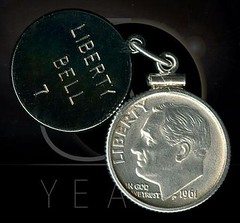 In honor of NASA's anniversary, collectSPACE
offers the following colorful tour through the agency's first 50 years as
guided by the space collectibles it inspired.
In honor of NASA's anniversary, collectSPACE
offers the following colorful tour through the agency's first 50 years as
guided by the space collectibles it inspired.1961: The first NASA astronaut to fly was Alan Shepard but his carry-on luggage was limited to little more than a U.S. flag. Gus Grissom, who followed Shepard, packed his pockets with miniature Mercury capsules and dimes (like this one; Liberty Bell 7 was the name he bestowed his spacecraft, which sank after splashdown and wasn't recovered until July 1999).
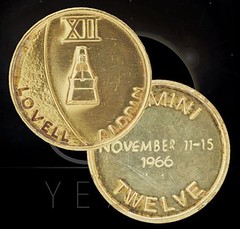 This coin (or more appropriately, medal) flew on
Gemini 12, the last mission of the program that taught astronauts how to
walk and meet each other in space (a.k.a. "EVA" and "rendezvous"). They
were "go" for the Moon, or so they thought...
This coin (or more appropriately, medal) flew on
Gemini 12, the last mission of the program that taught astronauts how to
walk and meet each other in space (a.k.a. "EVA" and "rendezvous"). They
were "go" for the Moon, or so they thought...To read the complete article, see: NASA@50: Fifty years of space collectibles (http://www.collectspace.com/news/news-100108a.html)
THE COIN COLLECTION AT THE MUSEO NAZIONALE ROMANO
Nathan is a Ph.D. Candidate in Greek and Roman Art and Archaeology at the University of Missouri, writing a dissertation on Architectural Coin Types: Reflections of Roman Society. -Editor
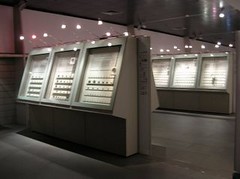 One place I have consistently visited every
time I go to Rome is the Museo Nazionale Romano - Palazzo Massimo alle
Terme. The museum is located next to Termini train station and contains a
very import collection of sculpture, wall paintings and, of course, coins.
Naturally, this museum was on our itinerary, since I wanted to ogle the
magnificent numismatic collection once again. My mother was not as
impressed with the coins as she was with the wall paintings, sculptures,
and fine mosaics, but I was able to make a quick jaunt through the
basement vault where the coins are kept anyway.
One place I have consistently visited every
time I go to Rome is the Museo Nazionale Romano - Palazzo Massimo alle
Terme. The museum is located next to Termini train station and contains a
very import collection of sculpture, wall paintings and, of course, coins.
Naturally, this museum was on our itinerary, since I wanted to ogle the
magnificent numismatic collection once again. My mother was not as
impressed with the coins as she was with the wall paintings, sculptures,
and fine mosaics, but I was able to make a quick jaunt through the
basement vault where the coins are kept anyway.Unlike most of the important western collections of ancient coins, those in Rome often contain significant proportions of coins that are known to have been recovered in Rome and Italy. Most of the coins in the cases at the Palazzo Massimo come from the private collection of Francesco Gnecchi, a numismatic scholar from the late 19th and early 20th century, but other displays include excavated hoards and finds as does its larger inventory which cannot be displayed at once. Some 60,000 - 70,000 ancient coins from the Rome, which were recovered during the risorgimento, await publication by the numismatists at Frankfurt. Some finds from the Tiber River have already been published.
 The extensive display at the Palazzo Massimo
allows visitors to view the evolution and development of the Roman
monetary system in a chronological fashion and also includes later
medieval and modern coins from Italy.
The extensive display at the Palazzo Massimo
allows visitors to view the evolution and development of the Roman
monetary system in a chronological fashion and also includes later
medieval and modern coins from Italy. Unlike most museums containing ancient coin displays, the cases at Palazzo Massimo have magnifiers that visitors can manipulate electronically to view select coins in greater detail. Often, however, I have found some of these inoperable. Nevertheless, any numismatist or ancient coin enthusiast who passes through Rome ought to visit this collection and the other important holdings of this fantastic museum. In some ways it's a much more enjoyable experience than visiting the Capitoline Museums or the Vatican Museums, where one has to fight the throngs of tourists.
To read the complete article, see: The Coin Collection at the Museo Nazionale Romano - Palazzo Massimo alle Terme (http://coinarchaeology.blogspot.com/2008/09/coin-collection-at-museo-nazionale.html)
QUERY: WHERE IS THE GOLD COIN CLARE BOOTHE LUCE GAVE TO JFK?
In the summer of 1943, Lieutenant "Jack" Kennedy commanded a PT boat operating against the Japanese near the island of New Georgia in the Pacific. One night Kennedy's boat was rammed and cut in two by a Japanese destroyer. Although injured during the attack, Kennedy and most of his crew survived.
A few months later, Kennedy again wrote to Luce. With his note he enclosed a gadget, originally intended to be a letter opener, made "from a Jap 51 cal. bullet and the steel from a fitting on my boat, part of which drifted onto an island." He concluded the note with a word of thanks for Luce's earlier gift:
To read the complete article, see: Today in History: September 29 (http://memory.loc.gov/ammem/today/sep29.html)
STEVEN TEMBY: AN AUSTRALIAN B. MAX MEHL?
Dick Johnson writes:Get coins in quantity from a bank, spend an hour or two each evening searching, and take the unwanted coins back to the bank, his publicity directs. "There are over 150,000,000 of these rare coins in circulation today."
Is he a reincarnated B. Max Mehl? At least Mehl gave you a book to read -- the Star Rare Coin Encyclopedia -- for a few dollars. How much did he offer for a 1913 Liberty Head nickel?
To read Steven Temby's press notice, see: Rare coins give all Australians a reason to cash in for big profits (http://www.seekingmedia.com.au/news.php?newsid=431)
CELTIC COIN PROFILE RESEMBLES MARGARET THATCHER
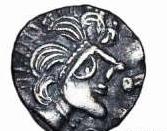
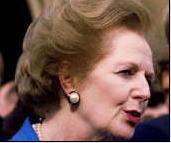
David Baker was searching a muddy field near Grantham when he uncovered the 2,000-year-old silver coin. On one side was the head of a tribal leader or goddess which passed an uncanny resemblance to the former Prime Minister.
"It is so ironic that she was born close to where I found it and that it is also from the Iron Age - and she was known as the Iron Lady." Only 10 of these celtic coins from about 40BC have ever been found and, according to one expert, this is the finest ever unearthed. It is said to be of the Trinovantian tribe that were from north of the Thames.
To read the complete article, see: Metal detector unearths Iron Age Iron Lady (http://www.thisislincolnshire.co.uk/news/
Metal-detector-unearths-coin-resemblance-Margaret-Thatcher/article-368472-detail/article.html)
FIRM OFFERS GREEK-STYLED BARACK OBAMA MEDALLION
 Against an elaborate backdrop resembling a
Greek temple, Barack Obama delivered his acceptance speech. An audience of
about 84,000 people in the stadium and 40 million TV viewers witnessed
this extraordinary event. So what could be a better tribute to Obama than
this commemorative coin that marks the occasion that has now become a
defining moment in history for millions of people everywhere.
Against an elaborate backdrop resembling a
Greek temple, Barack Obama delivered his acceptance speech. An audience of
about 84,000 people in the stadium and 40 million TV viewers witnessed
this extraordinary event. So what could be a better tribute to Obama than
this commemorative coin that marks the occasion that has now become a
defining moment in history for millions of people everywhere.This stunning profile portrayal of Barack Obama is designed in the bold, beautiful Hellenistic style of an Ancient Greek coin. Although the coin honors Obama.s nomination, it is also intended as a cultural outreach gesture from Greece to those who support Obama in the U.S. and abroad.
The face of the coin shows Obama wearing the headdress of the legendary lion-skin cape that protected the mighty Hercules from his enemies.
To read the complete article, see: BarackO Champions Coin (http://apazog.wordpress.com/2008/09/29/baracko-champions-coin2/)
FEATURED WEB PAGE: THE ART OF MONEYGAMI
This week's featured web page is The Art of Moneygami.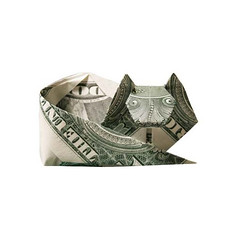


art.commongate.com/post/the_art_of_moneygami
